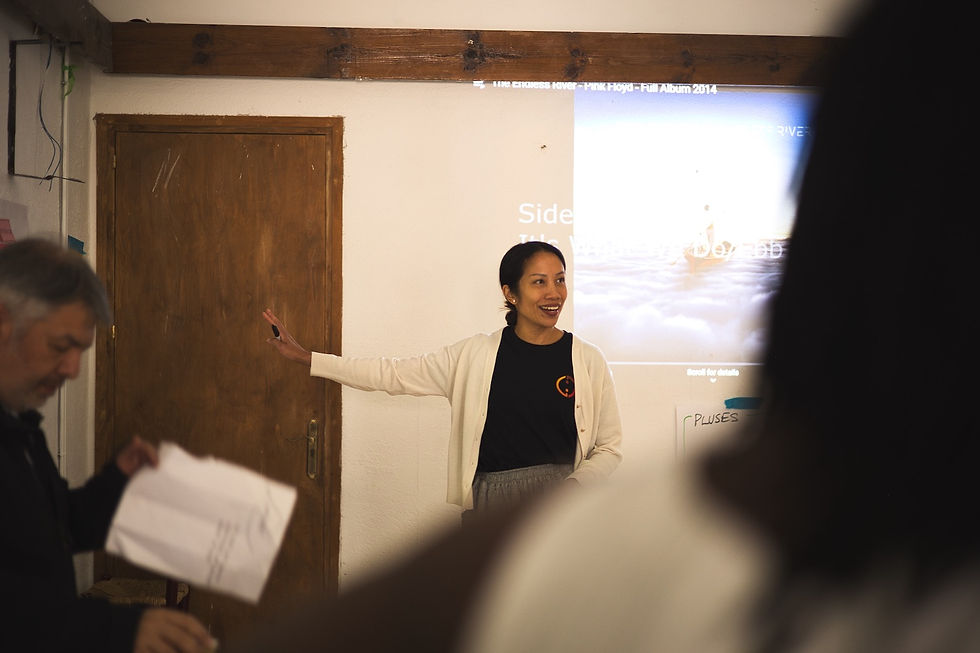Facilitating Across Hierarchies
- maggiedugan
- May 20
- 3 min read
Updated: Aug 26
Power is always in the room—whether we name it or not.
Last month, we piloted a new workshop called Navigating Hierarchy, designed to help creative collaborators make that power visible—and learn to work with it. The session invited participants at the CREA conference to examine how status shapes group dynamics, especially in spaces where innovation and co-creation are the goal. We hosted twenty curious participants, and walked away with insights we'll carry forward in refining this material.
We started with an activity that quickly revealed how easily power can be assigned—or perceived—based on arbitrary information. As people gravitated toward others holding “high” or “low” numbers, the metaphor for real-world dynamics became tangible. We followed it with a key quote that grounded our work: “Power is authored by all the members of a system. Power manifests in both structured and unstructured social interactions.”

That framing guided us through the rest of the session. Using a tool adapted from the Swiss nonprofit Recipes for Wellbeing, participants created custom “Power Wheels”—maps of the status dynamics that might exist within different types of group gatherings. Whether designing for a corporate strategy session, a cross-cultural NGO meeting, or a creative workshop like at CREA, people explored which identities, roles, and resources are likely to grant or deny someone influence.
The conversations that followed were rich. One learning that stood out: power structures exist for a reason—and they’re not inherently bad. In fact, hierarchy can provide clarity, safety, and efficiency. But when left unexamined, these structures can also stifle innovation, silence marginalized voices, and replicate inequity. The challenge, then, isn’t to eliminate hierarchy altogether—it’s to navigate it with intention.
We introduced this list of practical “mechanisms” that help flatten status within a group during a workshop:
Minimizing plenary discussions to prevent extroverts from dominating.
Using tools and activities that limit opportunities to monopolize the conversation.
Sharing and enforcing process agreements—especially with high-status participants.
Encouraging common dress to minimize visible status differences.
Creating opportunities to laugh together and build social cohesion.
Failing together in low-stakes activities to reduce fear and level the playing field.
Succeeding together through shared accomplishments.
Designing moments where those with lower status can succeed or shine.
Engineering disadvantages for high-status individuals
Inviting participants to survive embarrassment (e.g., by sharing an emotion) to build empathy.
Reminding high-status individuals of their position and encouraging self-monitoring.

Participants returned to their Power Wheels to brainstorm which mechanisms might apply to the particular hierarchies they’d mapped. Could laughter help loosen cultural stiffness? Might minimizing plenary discussions make space for quieter voices? Does it help to name those with power in the room, and hold them accountable to listening openly? The groups worked to pair these (and other) tactics to different contexts.
One prompt that generated particularly meaningful discussion was: “What do you do before a workshop even starts to level the playing field?” People shared rituals, room setups, pre-workshop communications, and community agreements that have helped them prepare inclusive spaces before even a single word is spoken.
Culture shapes everything — including creativity — and at the heart of culture are dynamics of power.
We ended the workshop with a simple reminder: culture shapes everything — including creativity — and at the heart of culture are dynamics of power. If we want to unlock true collaboration and innovation, we need to understand how status operates in the spaces we lead. More importantly, we need tools to work with it—not just in theory, but in practice.

The conversations that this workshop sparked—and the clarity it surfaced—confirmed how vital it is to name and navigate power in creative spaces. We’re energized to keep evolving this work, and committed to building tools that help facilitators, leaders, and collaborators work more equitably across differences. If this resonates with you—if you’re grappling with hierarchy in your own spaces—we’d love to connect, learn together, and explore what’s possible.
Go Further:
Addressing power dynamics to be more inclusive and equitable in the co-creation process. More about the Wheel of Power and Privilege. A group activity to help people step into each other’s shoes, and a tool for power mapping.




Comments